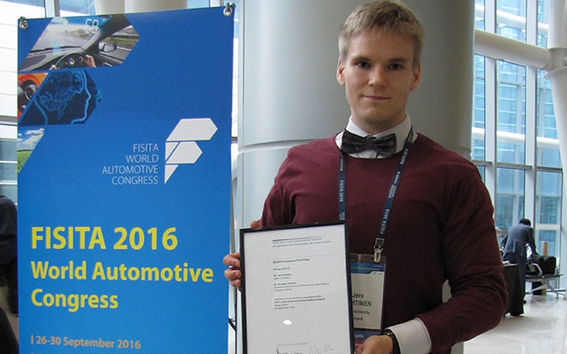FISITA student award came to Aalto University

Lehtinen won the award for best presentation at the student congress of the International Federation of Automotive Engineering Societies (FISITA). The topic of his presentation was ‘Nonlinear Lateral Dynamic Behaviour of a High Capacity Transport Vehicle’.
Lehtinen was presented with the award at the closing ceremony of the World Automotive Congress held in September in the South Korean city of Busan. A total of 1800 participants from 33 different countries attended the congress. The congress is held every other year.
‘It was great to receive recognition from experts in the field,’ said Lehtinen with satisfaction.
The jury rated the presentation as an outstanding paper. There were a number of criteria involved, such as the originality, innovation, theoretical use and practical use of the research.
Safely onto the road
High Capacity Transport (HCT) refers to articulated heavy vehicles which are longer or heavier than national legislations allow, but which are nevertheless not considered to be oversize transports. Such vehicles are currently introduced in Finland’s traffic circulation, particularly for the transport of timber. In order to use such vehicles, a transportation company needs to acquire a test permit from the Finnish Transport Safety Agency (Trafi).
HCT vehicles are known in Australia as ‘road trains’. These can also be seen on Swedish roads as well as in certain central European countries and in Canada.
The greater transport capacity is aimed at increasing productivity and reducing energy consumption relative to the vehicle’s payload. This means lower emissions and reduced transport costs.
For his master’s thesis, Jere Lehtinen studied the nonlinear lateral dynamic behaviour of a certain articulated heavy vehicle (HCT) in slippery road conditions.
‘Currently, HCT vehicles cannot be driven in winter and sub-zero conditions. Authorities want to receive more information about the vehicles’ stability and safety when operating in demanding conditions before they provide transport permits for such conditions.’
Lehtinen used different articulated vehicle parameters to perform sensitivity analyses of how the HCT vehicle behaves during different driving manoeuvres. He studied the impact of different parameters on the nonlinear lateral dynamics of the HCT vehicle, and how the vehicles’ structure could be developed so that it would exhibit more stable behaviour and would promote straightening in various driving manoeuvres, such as in different kinds of lane changes and problematic exceptional circumstances. These problematic exceptional circumstances were modelled by introducing a new phase plane method for heavy vehicle combinations.
‘The large HCT vehicle demands anticipatory driving from the driver. When, for example, the driver steers the vehicle while driving at a forward velocity of 80km/h, the effect of steering motion only reaches the back-end of the vehicle around two seconds later.’
Jere Lehtinen studied the behaviour of HCT vehicles in the laboratory of Automotive Engineering Research Group in the Aalto University School of Engineering. In Oulu University the same topic is being studied using real-life driving tests and measurements. The research is being carried out in cooperation with Trafi, the Technical Research Centre of Finland (VTT) and different businesses and foundations from within the automotive industry.
Towards new challenges
Lehtinen completed his master’s thesis at the end of 2015. In autumn 2016 he transferred to the Department of Industrial Engineering and Management to begin postgraduate studies.
‘Industrial engineering and management was my minor subject. I concentrate now on research related to project and organizations management, and leadership, all of which are interesting topics for me’.
Lehtinen notes that there has been a reduction in the amount of teaching and funding for automotive engineering at Aalto University School of Engineering.
‘I hope that teaching and research on vehicle and tyre dynamics remain at a high level in Finland. Research is needed for academic and practical purposes, because we want to develop tyre and vehicle dynamic theories for facing exceptionally challenging road conditions in Finland due to seasonal variations and the particularly challenging winter conditions.’
According to Lehtinen, automotive research and industry developments on a worldwide scale are increasingly focused on developing electricity-powered vehicles and self-driving vehicles.
Photo: Pasi Perhoniemi, SATL
Read more news

Two Unite! Seed Fund projects involving Aalto secure top EU funding
Two prestigious EU grants have been awarded to projects that were initially supported with Unite! Seed Funding. Both projects involve Aalto.
Chem Awards 2025 recipients announced
The School of Chemical Engineering recognises outstanding individuals and teams for their exceptional contributions over the year
Research into physics of microscopically tiny organisms lands prestigious prize
Physics Professor Matilda Backholm received this year’s Väisälä award, handed out by the Finnish Academy of Sciences and Letters.






